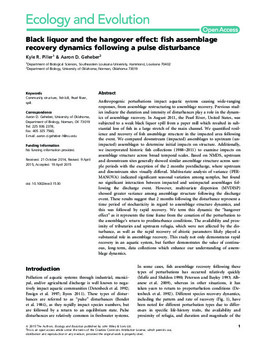| dc.contributor.author | Piller, Kyle R. | |
| dc.contributor.author | Geheber, Aaron D. | |
| dc.date.accessioned | 2015-06-01T16:32:18Z | |
| dc.date.accessioned | 2015-08-24T19:51:49Z | |
| dc.date.accessioned | 2021-04-14T15:05:37Z | |
| dc.date.available | 2015-06-01T16:32:18Z | |
| dc.date.available | 2015-08-24T19:51:49Z | |
| dc.date.available | 2021-04-14T15:05:37Z | |
| dc.date.issued | 2015-05-25 | |
| dc.identifier.citation | Piller, K. R. and Geheber, A. D. (2015), Black liquor and the hangover effect: fish assemblage recovery dynamics following a pulse disturbance. Ecology and Evolution. https://doi.org/10.1002/ece3.1530 | en_US |
| dc.identifier.uri | https://hdl.handle.net/11244.46/17 | |
| dc.description.abstract | Anthropogenic perturbations impact aquatic systems causing wide-ranging responses, from assemblage restructuring to assemblage recovery. Previous studies indicate the duration and intensity of disturbances play a role in the dynamics of assemblage recovery. In August 2011, the Pearl River, United States, was subjected to a weak black liquor spill from a paper mill which resulted in substantial loss of fish in a large stretch of the main channel. We quantified resilience and recovery of fish assemblage structure in the impacted area following the event. We compared downstream (impacted) assemblages to upstream (unimpacted) assemblages to determine initial impacts on structure. Additionally, we incorporated historic fish collections (1988–2011) to examine impacts on assemblage structure across broad temporal scales. Based on NMDS, upstream and downstream sites generally showed similar assemblage structure across sample periods with the exception of the 2 months postdischarge, where upstream and downstream sites visually differed. Multivariate analysis of variance (PERMANOVA) indicated significant seasonal variation among samples, but found no significant interaction between impacted and unimpacted assemblages following the discharge event. However, multivariate dispersion (MVDISP) showed greater variance among assemblage structure following the discharge event. These results suggest that 2 months following the disturbance represent a time period of stochasticity in regard to assemblage structure dynamics, and this was followed by rapid recovery. We term this dynamic the “hangover effect” as it represents the time frame from the cessation of the perturbation to the assemblage's return to predisturbance conditions. The availability and proximity of tributaries and upstream refugia, which were not affected by the disturbance, as well as the rapid recovery of abiotic parameters likely played a substantial role in assemblage recovery. This study not only demonstrates rapid recovery in an aquatic system, but further demonstrates the value of continuous, long-term, data collections which enhance our understanding of assemblage dynamics. | en_US |
| dc.language | en_US | en_US |
| dc.subject | Community structure; fish kill; Pearl River; spill; assemblage recovery | en_US |
| dc.title | Black liquor and the hangover effect: fish assemblage recovery dynamics following a pulse disturbance | en_US |
| dc.type | Article | en_US |
| dc.description.peerreview | Yes | en_US |
| dc.identifier.doi | https://doi.org/10.1002/ece3.1530 | en_US |
| ou.group | College of Arts and Sciences::Department of Biology | en_US |
| dc.description.undergraduate | undergraduate | |
